mobile View, to the German Version tap the flag


- Tyrol (Tirol)
- Federal Country of the Republic of Austria
- former Austrian crown land: Princely County of Tyrol
• Flags of the federal country of Tyrol
• Historical Flag
• Other Flags
• Meaning/Origin of the Flag
• Coat of arms of the federal country of Tyrol
• Other coats of arms
• Meaning/Origin of the Coat of Arms
• Map of the federal countries of Austria
• Map of the former crown lands of Austria-Hungary (to 1918)
• Map of South Tyrol
• Numbers and Facts
• History
• Origin of the Country's Name
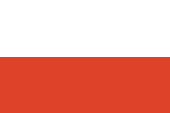
Flag of the country (Colours of the country),
ratio = 2:3,
Source, by: Wikipedia (D),
Färbung, nach: Dr. Peter Diem www.peter-diem.at



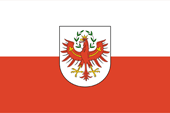
Official flag,
ratio = 2:3,
Source, by: Wikipedia (D),
Färbung, nach: Dr. Peter Diem www.peter-diem.at







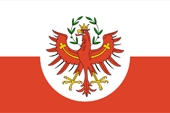
1946–1949,
Flag of the country (Colours of the country),
ratio = 2:3,
Source, by: Flaggen Enzyklopädie





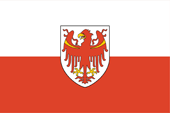
Official flag of South Tyrol (Alto-Adige),
ratio = 2:3,
Source, by: F l a n k e r / CC BY via: Wikipedia (D)





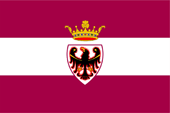
Official flag of the Trento Province (Trentino),
ratio = 2:3,
Source, by: User:Fulvio314 / Public domain, via: Wikipedia (D)




The flag of Tyrol descents from the early 19. century and shows two stripes in white and red. It was introduced on 10th of March in 1949. The colours of the flag are derived from the colours of the coat of arms (red eagle on silvery ground).
In the time of the monarchy, the country had – like all the other crown lands of the Austrian crown – its own colours (Landesfarben), which were used amongst others on horizontally two- or three-striped flags. The colours (Landesfarben) were very often taken from the respective coat of arms of the country or were supplemented by another colour, which not appears in the coat of arms, or they went back to older models of the coat of arms (e.g. Carniola). Officially, the colours had never been regulated or stipulated, so that their sequence varied in practice or even the colors deviated. The Austrian heraldist Hugo Gerard Ströhl (1851–1919) was probably the first to take care of it and asked for the colors (Landesfarben) on the flags at the respective state authorities around 1890 and compiled them. For Tyrol, white and red were ascertained as the country's colors of the crown land.
Austria joined the German Empire in 1938 as one country. The federal structures played no role, they were completely replaced by the NSDAP districts (NS-Gau), the countries were abolished. From now on, offices and authorities had to use the empire's official flag. The corresponding national colors may still have exist, but not in the form of flags. They may have been used sporadically on SA uniforms or in some ranks of the Hitler Youth in the chest cord.
The flags of the Federal States of Austria are used with or without the coat of arms. For official use, however, they always show it. The general population is permitted to use this format as well.
The flag of Tyrol, which was introduced in the year 1946 and which was replaced by the today's model in the year 1949, shows the eagle enlarged in the middle of the white-red flag on a white disc. It still enjoys some popularity, but is gradually going out of fashion, the flag with the coat of arms is much more common.
There do not seem to be any legal regulations for the colours of the flags of the Austrian federal states; since they are apparently not defined, they are reproduced in practice within a usual standard range. However, the Austrian publicist and media scientist Dr. Peter Diem gives recommendations for the reproduction of the colours: For Tyrol, a bright red, most likely corresponding to Pantone 179.
Source: Dr. Peter Diem austria-forum.org,
Wikipedia (D),
Flaggen Enzyklopädie,
Flags of the World,
Volker Preuß,
Österreichisch-Ungarische Wappenrolle


since 1946,
Coat of arms of Tyrol,
Source, by: Landeswappen (PDF) / Public domain Wikipedia (D),
Colour, by: Dr. Peter Diem www.peter-diem.at

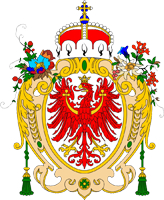
ca.1890–1918,
Coat of arms of the Princely County of Tyrol,
Source, by: Ströhl, Wappenrolle Österreich-Ungarns, 1890, via Wikipedia (D)

since 1983,
Coat of arms of the Province of South Tyrol in Italy,
Source, by: Helga von Aufschnaiter, by: F l a n k e r / Public domain
via: Wikipedia (D)

since 1988,
Coat of arms of the Trento Province in Italy,
Source, by: King John of Bohemia (vectorized by Gothika)This W3C-unspecified vector image was created with Adobe Illustrator. / Public domain via: Wikipedia (D)

"The Tyrolean coat of arms shows a red eagle on a silver shield with a golden crown. The eagle looks to the heraldic right and is armed with golden claws and legs, golden bars in the wings ending in a shamrock and a green wreath, open on the top, behind its head." Quote of Dr. Peter Diem on: Flags of the World
"The ancient coat of arms of Tyrol „red eagle on silvery (white) ground“ is handed down in colored depictions since 1271 resp. 1286. As the oldest reproduction counts the fresco in the chapel of Tyrol Castle in the times between 1271 and 1286. A description – with details of the colours created about 1250 with the scutcheon-poem (Clipeus Teutonicorum) by the Canon Konrad on Mure – says: „Fert aquilam Tyrolis clipeus prestante rubore, que nigri pedis est alias albente colore“ (The white shield of Tyrol carrys an eagle of outsticking red colour and black feet). In difference was it since the 14th century usual to dye the catches and the arms of the eagle in gold. In the year 1416 the eagle got a crown and in 1567 a green wreath around its head." Quote of: Mirko Costa, Bruneck, Südtirol
The Tyrolean eagle is used in various forms by different political bodies, such as the Austrian federal country of Tyrol, but also by the Autonomous Province of South Tyrol (Alto-Adige) and similarly in the Autonomous Province of Trento (Trentino, in German: Welschtirol). The two autonomous provinces of South Tyrol and Trento together form the Italian region of Trento-South Tyrol (Trentino-Alto-Adige).
In principle, the eagle is always the same, only inspired by historical models, as the coat of arms looked at specific times in a specific century, or an artist redesigned the coat of arms. In this way the today's coat of arms of the federal country of Tyrol was created in 1946. The eagle bears the crown awarded in 1416 and the coat of arms shows the green wreath, which was added in 1567. The green wreath was practically revived, because in the past times it was not shown. For South Tyrol, the template is the coat of arms of the Counts of Tyrol, executed like on the right wing outside of the altar of Castle Tyrol from 1370, with golden wing clips. It was redesigned in 1982 by the artist Helga von Aufschnaiter. In this form, the coat of arms was confirmed in 1983 by the Italian President. For Welschtirol (Province of Trento) the template is that coat of arms which Nikolaus Abrein, Prince-Bishop of Trento between 1338 and 1347, introduced in 1339. It is also an eagle, but black, with golden wing clips and shamrock ends, in a red flame wreath. Such an eagle model is called "Wenceslas Eagle", named after St. Wenceslas, a martyr and Bohemian prince from the ruling Přemyslid family from the first half of the 10th century.
In the times of the Austrian crown land above the blazon was situated even a crown, exactly a prince's hat. It remembers and stands for the princely county. The Austrian heraldist Hugo Gerard Ströhl surrounded the coat of arms ca. 1890, in its last known version, with for the country typical flora. For the Princely County of Tyrol this had been stylized reed leaves, which should emphasize the country's location in the Alps and in the south of it.
Source: Wikipedia (D),
Flaggen Enzyklopädie,
Dr. Peter Diem on: Flags of the World,
Source: Mirko Costa, Bruneck, Südtirol,
Volker Preuß,
Österreichisch-Ungarische Wappenrolle

The federal countries of Austria:
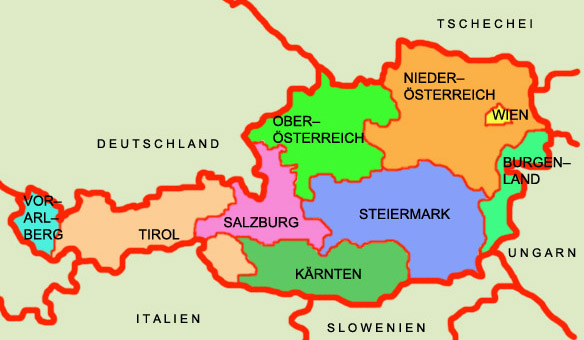
Source: Volker Preuß
• Burgenland
• Carinthia (Kärnten)
• Lower Austria (Niederösterreich)
• Upper Austria (Oberösterreich)
• Salzburg
• Styria (Steiermark)
• Tyrol (Tirol)
• Vorarlberg
• Vienna (Wien)

Map ca. 1910:
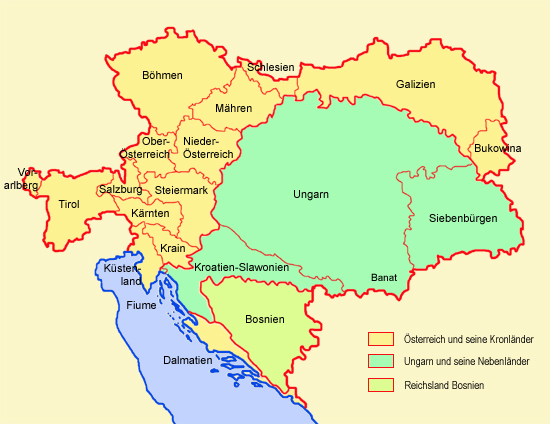
Source: Volker Preuß

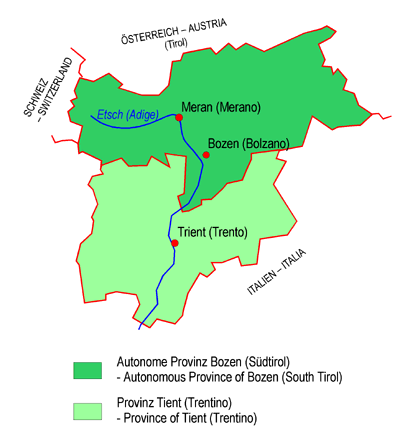
Source: Volker Preuß

Area: 4.880 square miles
Inhabitants: 754.700 (2019)
Density of Population: 155 inh./sq.mi.
Capital: Innsbruck, 132.100 inh. (2019)
official Language: German
Currency: 1 Euro = 100 Cent
Time Zone: MEZ
Source: Wikipedia (D)

Antike · in the today's Country of Tyrol settle Raetians, Illyrians, Etruscians and Celts
since 14 B.C. · Roman conquest, establishment of the Provinces of Noricum and Raetia
166–168 · invasions of the Teutonic tribe of the Marcomans
213 · invasions of the Alemannes
409–452 · invasions of the Hunse
476 · dismissal of the last Roman emperor Romulus Augustulus, end of the (West)Roman Empire, in the today's Tyrol comes to the Empire of the Eastern Goth
536 · conquest by the Frankish Empire of the Merowingians, settlement by Bajuwares and Langobardes, nascence of the Duchy of Bavaria to which the today's Tyrol belongs
788 · conquest of Bavaria by the Frankish Empire of the Carolingians
843/870/880 · at the division of the Frankish Empire Tyrol becomes partitioned, the north comes to the East Frankish Empire (later named German Empire), and the south (Counties of Trient and Brixen, both later dioceses) to the Mark of Verona which belongs to Italy
12th century · consolidation of the territory by the Counts of Tyrol, separation from Bavaria
1258 · vanish of the Counts of Tyrol, the country comes to the House of Goerz
1363 · the County of Tyrol comes to the House of Habsburg
1803 · German Mediatisation, the Dioceses of Brixen and Trient become secularized and affiliated to Tyrol
26th of December 1805 · Peace of Pressburg after the Third Coalition War, Austria has to cede Tyrol to Bavaria
1809 · after riotings become Tyrol partitioned between the Kingdom of Italy (Southern Tyrol), the French Illyria (Eastern Tyrol) and Bavaria (Northern Tyrol)
1814/1815 · Vienna Congress for a realignment of Europe after Napoléon, whole Tyrol comes to Austria
1849 · revolution, new constitution: the titular hereditary territories of the Habsburgs in the Austrian Empire become converted to crown lands with their own Landtag (parliament),
just as well the Princely County of Tyrol
12th of November 1918 · proclamation of German Austria to the Republic of Austria, Tyrol becomes an Austrian federal country
10th of September 1919 · Peace Treaty of St. Germain, Austria has to cede Tyrol southern the Brenner Mountain Pass (quasi South Tyrol) to Italy
13th of March 1938 · annexation of Austria to the German Empire, the administrative "NS-Gau of Tyrol-Vorarlberg" takes the place of the Country of Tyrol
27th of April 1945 · proclamation of the Republic of Austria "Second Republic", Tyrol becomes again an Austrian federal country, but stays occupied by French troops until 1955
1948 · 1st statute of autonomy for the Province of South Tyrol (in Italy)
1955 · withdrawal of the occupation troops
1972 · 2nd statute of autonomy for the Province of South Tyrol (in Italy)
Source: Atlas zur Geschichte,
Wikipedia (D),
World Statesmen,
RetroBib Retrobibliothek,
Discovery '97,
Volker Preuß

The name "Tyrol" has its roots in Castle of Tirol near Meran (today Southern Tyrol) from where the first Counts of the Country descent. The name "Tyrol" itself could be of Celtic origin, because ter or tir means "soil", "field" or "ground", Tyrol would literally be the "Soilland".
What is a Princely County? A county is ruled by a count. A count is usually subordinated to a higher noble, e.g. a duke - the county is therefore part of a duchy. In contrast to the count, a duke belongs to the nobility as imperial prince, is directly subordinated to the emperor and has access to the imperial prince's council, which advises the emperor. However, the emperor was able to elevate a count to the rank of an imperial prince, without that he received a new and higher title. He had access to the imperial prince's council and was called "princely count" or "imperial count".
Source: Wikipedia (D),
Atlas der wahren Namen

Further Austria pages (historical flags and coats of arms):
• Empire of the Austrian Habsburgs (to 1804)
• Empire of Austria (1814–1867)
• Austria-Hungary (1867–1918)
• Republic of Austria (since 1918)

![]()

























